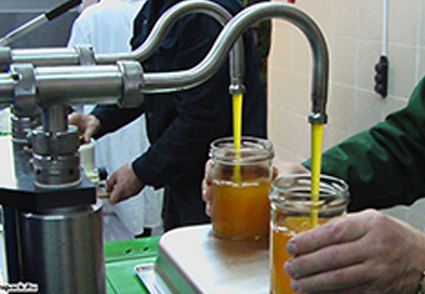
თაფლის გადამუშავება
ფუტკარი იძლევა 6 სახის ეკოლოგიურად სუფთა ნატურალურ პროდუქტს. მიღებული კლასიფიკაციის მიხედვით აღნიშნული პროდუქტები იყოფა ორ ძირითად ჯგუფად:
- ბუნებაში არსებული მცენარეული ნივთიერებების ფუტკრის ორგანიზმში გადამუშავების შედეგად მიღებული პროდუქტები:
- თაფლი,
- დინდგელი,
- ყვავილის მტვერი
- ფუტკრის ორგანიზმში გამომუშავებული სეკრეტორული პროდუქტები:
- ფუტკრის სადედე რძე,
- ცვილი,
- ფუტკრის შხამი.
ნექტრის თაფლად გადამუშავება პროცესები:
-ზედმეტი წყლის მოცილება
- შაქრის ინვერსია და
- მჟავე რეაქციის მიღება
ნექტრის შემოტანა სკაში, გადამუშავება და დაბინავება და ზედმეტი წყლის მოცილება-ინტენსიური ღალის დროს ფუტკარი გარედან შემოტანილ ნექტარს სკაში მომუშავე ფუტკარს გადასცემს, რომელიც მას განალაგებს წვეთების სახით. ნექტრიდან ზედმეტი წყლის აორთქლებისათვის ბუდეში იქმნება საჭირო მიკროკლიმატი: ტემპერატურა 34-350C-ის ფარგლებში და ბუდის ინტენსიური ვენტილირება. ამის წყალობით 3-4 დღეში ნექტრის კონდიცირება (შედგენილობის საჭირო ცვლილებები) ძირითადად დამთავრებულია: წყლის შემცველობა დამწიფებული თაფლის მაჩვენებელს უახლოვდება, მაგრამ რთული შაქრების გარდაქმნა მონოშაქრებად (ფრუქტოზა, გლუკოზა) კიდევ გრძელდება 2-3 კვირას და მიმდინარეობს ინტენსიური მუშაობა ნექტრის თაფლად გარდაქმნისათვის.
თაფლის გადამუშავება დასრულებულად შეიძლება ჩაითვალოს მას შემდეგ, რაც
ფუტკარი თაფლიან უჯრედებს გადაბეჭდავს ცვილის თხელი ფენით (ფირფიტებით).თაფლის წურვა ფიჭებიდან მაშინ შეიძლება, თუ თაფლის 2/3 მაინც ცვილით არის გადაფარული.
თუმცა საჭიროა.
თაფლის დაგროვებასთან ერთად (აქტიურ სეზონზე)ფუტკარი მას ინტენსიურად
ხარჯავს. დადგენილია, რომ წლიურად სრულფასოვანი ოჯახი ხარჯავს 90-110 კგ თაფლს,აქედან 20-25 კგ-ს - ზამთრობის პერიოდში (მისი ხანგრძლივობიდან გამომდინარე),ხოლო სასაქონლო თაფლის რაოდენობა საშუალოდ 10-30 კგ-ს არ აღემატება.
თაფლის გამოწურვა - მეფუტკრეობის პრაქტიკაში ეს ერთ-ერთი შრომატევადი პროცესია. მეფუტკრეთა უმრავლესობა თაფლის სკიდან გადასასხმელად ცენტრიდანულ საწურს იყენებს. საწური შიძლება იყოს ხის,ან - ალუმინის. უმჯობესია უჟანგავი ფოლადის საწური, რაც ნორმას წარმოადგენს საკვების უსაფრთხოების კუთხით.
შემდეგი საფეხურია გაწურვა: თაფლს 30-35C-მდე აცხელებენ, შემდეგ საწურში ფილტრავენ (ბადის უჯრედის ზომა 0.8-და 1მმ- მდეა), ან ცილინდრულ საცერში (0.4-დან 0.5 მმ-მდე).
უმეტესობა ქორდული ციბრუტებით არის წარმოდგენილი (ტევადობა-3-4 ჩარჩო).აუც აუცილებელია შემთხვევით მოხვედრილი ფუტკრის გასარეკად ფანჯრებს უნდა ჰქონდეთ სათანადო აღჭურვილობა (180°C-ით ჩარჩოების მობრუნების საშუალება), იყოს ვენტილაცია და შეიძლებოდეს ჰიგიენური მოთხოვნების დაცვა;
უმწიფარი და ამჟავებული თაფლის გადამუშავება- ასეთი თაფლის გამოწურვის შემთხვევები საკმაოდ ხშირია მეფუტკრეობის პრაქტიკაში, რაც განპირობებულია შემდეგიფაქტორებით:
_ თუ მეფუტკრეს არ აქვს სათადარიგო ფიჭების საკმარისი მარაგი, ის იძულებულია,
თაფლი გამოწუროს ნაადრევად, ნექტრის მარაგის სრულად ათვისების მიზნით. მეფუტკრეობის პრაქტიკაში უმწიფარი თაფლი დამატებით სითბურ დამუშავებას გადის. მისი კონცენტრაცია 80,5 მას.%-ს შეადგენს. სავალდებულოდ ითვლება ტენიანობის შემცირება 17,5-18%-მდე, რადგან ასეთიკონცენტრაციის თაფლში გამორიცხულია თაფლის ამჟავების პროცესის დაწყება.



